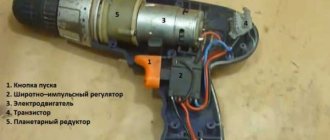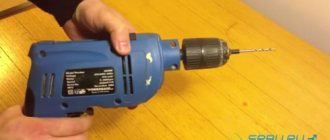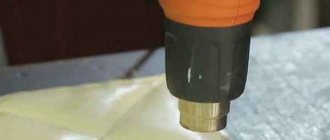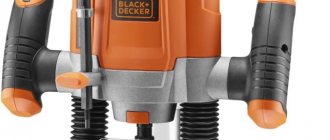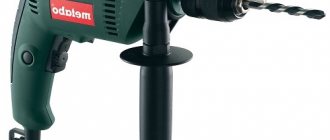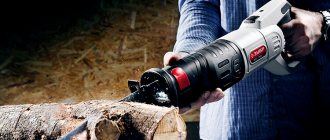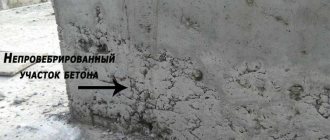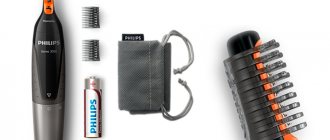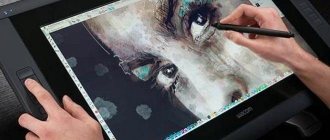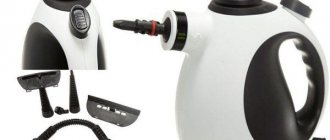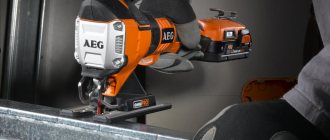Main types of bits
The most common self-tapping screws can be divided into two categories of cross-shaped products.
Phillips bits (PH)
There are no additional notches visible on the screw and the nozzle itself; the design is simpler. Depending on the size of this cross slot, there are bits PH0, PH1, PH2, PH3 and PH4. When working with wooden and metal products, crosspieces number 2 are most often used. Attachments PH3-4 are used primarily for larger objects or when repairing vehicles.
Cross and other attachments may differ slightly from each other not only in size, but also in shape or coating. In order not to get confused, you need to pay attention not only to the PH marking, but also to the article number. If the product indicates 000.0, then this is a classic cross PH bit. Regular cross bits are also available under the number 160.0, and the symbols 701.0 indicate a geometry called Exaform and the presence of titanium carbide coating. The 706.0 models simply provide a more durable finish with a standard nozzle shape. If the bit is coated with Tin coating (titanium nitride), then the article number should be chosen 101.0.
Healthy! The presence of Tin coating can be easily determined by the golden color of the nozzle. Such bits are characterized by increased strength, wear resistance and price. Products come in different lengths from 25 to 250 mm.
As a rule, products with additional reinforced coating are more expensive and are available in limited sizes.
Pozidriv bits (PZ)
Bits of this type are considered improved, since in addition to the standard cross shape, they are distinguished by additional edges with intermediate notches. Accordingly, for a self-tapping screw with additional notches and marking 2, you need to select a PZ2 bit. PZ bits are mainly used for galvanized self-tapping screws. Pozidriv type bits are available in three sizes - 1, 2 and 3.
Nozzles of this type also differ in the article number:
- 0 indicates that this is a classic Pozidriv bit;
- 0, as well as 2.716.0 are installed on nozzles with Tin coating;
Healthy! To determine that the bit is correctly selected for the screw, it is enough to connect both elements. If the products fit, the fastening element will not fall off.
If you give preference to the PH2 bit for the PZ2 self-tapping screw, the edges of the slot will very quickly begin to break off. Accordingly, not only the dimension is important, but also the type of bit and the screw itself.
Healthy! Self-tapping screws with a press washer for connecting soft products (for example, used in the construction of greenhouses) also come with a PH and PZ head.
Bits come in regular and extended lengths. The latter are applicable if you need to tighten a screw in a hard-to-reach place where the screwdriver itself cannot go. The length of products of this type usually reaches 150 mm, that is, the bit can be held in your hand like a regular screwdriver. As a rule, elongated models are also not available in all sizes, but only in the most popular ones, that is, No. 1, 2 and 3.
A set of bits for self-tapping screws and hex bolts. Success stories-2
Hello everyone, I present another review of a good consumable for power tools and the continuation of a series of successful stories :). This time a set of 14 bits for hex head screws. Not to say that a home craftsman will need such bits every day (for example, like cross bits), but for certain jobs he simply cannot do without them. I added another set of bits to my “collection”. Sometimes the next acquisition is “matured” for quite a long time before the time comes for its use, but this one has already come in handy and I’m sure it will come in handy in the future. In my purely personal opinion, these bits in everyday life are most often used in the country. Here are the types of work in which you simply cannot do without them: - installation of metal tiles, - assembly of a polycarbonate greenhouse, - installation of picket fences (including the newfangled metal one). all from personal experience 
As for the roof at my dacha, it is made of metal tiles, and although I did not personally take part in its installation, I, however, regularly monitored the process. But he was involved in greenhouse and fence matters in the most direct way. I think many of our dear readers will find a bunch of other uses for this type of consumable. It is clear that from the entire set, at best, a third of the bits of standard sizes will be used, but sometimes it happens that a non-standard size is “desperately” needed. In addition, it has been observed that single bits are lost after the first use. Therefore, for example, I never take an inexpensive consumable of the required size in one copy (or even in two) - with almost 100% probability, one copy will definitely be lost in the process (unless, of course, it breaks). In general, the set is good, and even a toad rarely shows signs of life in this matter. So, the set arrived in a sealed blister:
But he was involved in greenhouse and fence matters in the most direct way. I think many of our dear readers will find a bunch of other uses for this type of consumable. It is clear that from the entire set, at best, a third of the bits of standard sizes will be used, but sometimes it happens that a non-standard size is “desperately” needed. In addition, it has been observed that single bits are lost after the first use. Therefore, for example, I never take an inexpensive consumable of the required size in one copy (or even in two) - with almost 100% probability, one copy will definitely be lost in the process (unless, of course, it breaks). In general, the set is good, and even a toad rarely shows signs of life in this matter. So, the set arrived in a sealed blister:
In total, the set contains 7 inch and 7 metric bits. Inch: 3/16; 1/4; 8/32; 5/16; 1/32; 3/8; 7/16
Metric:
5;
5.5; 6; 7; 8; 10; 12 mm
Moreover, a Chinese product will not be Chinese if there is no mistake in the instructions or labeling. Pay attention in the photo below how the markings are applied - inches on top, millimeters on the bottom, and the bits in the holder sockets from the packaging are installed on the contrary, on top - mm, on the bottom - inches (this was right out of the package):
Dear reader will say: “Author, move the top ones down and vice versa, and don’t blow your mind, you will be happy,” but not everything is so simple. The holes themselves in the holder are, of course, not at equal distances, because... The diameter of the bits is different, and by the way, 3/16 inches is much smaller than 7/16, as is 5mm smaller than 12mm. That is, the marking is applied in a mirror form:
Well, okay, let’s consider this a funny misunderstanding, especially since the size is stamped on the bits themselves and is clearly readable:
Weight:
Dimensions:
The dimensions of the bits themselves, in addition to, of course, the diameter, differ slightly from each other in the height of the working part (depth of the head), as well as the length of the shank within 2-3mm. In principle, this does not affect anything. Example photo:
But the shanks themselves could be longer - their length does not exceed 25mm, which somewhat limits the use of bits in narrow places where the tool chuck would get in the way (although you can move the bit forward):
I can’t find fault with the quality of the bit’s manufacturing. The metal is smooth, without burrs:
The walls are thick, the geometry of the hexagons is flawless. The dimensions with the corresponding nuts match. In the plastic holder, the bits fit very tightly - it is quite difficult to pull them out by hand, there is no risk that they will fall out. A bow on one side allows you to hang them on your belt.
The dimensions with the corresponding nuts match. In the plastic holder, the bits fit very tightly - it is quite difficult to pull them out by hand, there is no risk that they will fall out. A bow on one side allows you to hang them on your belt.
Like any self-respecting consumable, it’s covered in oil. The bits, unfortunately, are not magnetized, but this can be solved if you find a suitable neodymium magnet:
I worked a little with one attachment with a file, the inside is the same metal as the outside (the presence of a CR-V was not declared by the manufacturer):
I tried to squeeze the head with a vice to check if the metal was soft and if the geometry would be broken:
In general, I almost broke the vice, the geometry remained normal (here, believe it or not :)) This is where the fantasy ended, reality began, that is, real application. As I already said, my main use for the bits was at the dacha, namely for assembling a greenhouse and covering the metal frame of the fence with a wooden picket fence. To do this, I used roofing screws (of different lengths), the use of which is much wider than indicated in their name:
For installation, I used an 8mm nozzle (although in fact, if you look at the table under the spoiler, the 5/16-inch nozzle, which also comes in the kit and corresponds to 7.9375mm, is better suited).
A little about roofing screws
Typical sizes of roofing screws
Roofing screws
for wood
according to GOST have a uniform diameter of 4.8 mm.
The length of the screws used is 29, 35, 38, 50, 60, 65, 70 and 80 mm. Self-tapping screws with a length of over 60 mm are used mainly for fastening corrugated material, which is structurally provided at the upper points of the wave, for example, for slate. Roofing screws for metal,
depending on their purpose, have diameters of 4.8; 5.5; 6.3 mm. Dimensions from 16 to 80 mm for smaller diameters, from 19 to 150 mm for self-tapping screws with a diameter of 6.3 mm. A length of less than 29 mm is used in fastening metal to metal, more than 80 mm is used for connecting to a multilayer lathing. (source _https://krovlya777.ru/materials/krovelnye-samorezy-razmery.html#chto-predstavlyayut-soboy-krovel-nye-samorezy) Roofing screws can be simply galvanized:
and painted in different colors, to match the desired color of corrugated sheeting (metal tiles):
Typical sizes:
In addition to installing the sheets themselves...
... are also used for fastening other elements of the roof structure:
Well, a little about installation:
In general, using the bits from the kit, the following greenhouse was assembled (hundreds of self-tapping screws were definitely needed):
At the request of the comments, I posted a photo after use. The bat is ok:
MORE
RESULT:
The bits are excellent; no beating was noticed during operation, which would indicate geometry defects. Quite suitable for regular use. The disadvantages include the “shortness” of the shanks and the lack of magnetization (this can be solved by installing a small magnet inside). A short video of use:
That's all.
All the best!
Other types of bits
Let's look at other common bit markings and what they are used for:
- SL (Slotted). This is a standard straight spline that has been used since the 18th century. The slot width ranges from 2 to 9 mm. Flat fasteners are used extremely rarely today, so such bits may be needed, for example, when working with old furniture. This type of nozzle is available in three variations: classic with a straight slot, with a straight slot and with Tin coating. These models can be distinguished by numbers 020.0, 191.0 and 122.0, respectively.
- H(Hex). These are hex bits. They differ depending on the distance from one face to another. The most common bit is the H4 model, since this type of fastener is used for furniture. Hexagons are usually easy to distinguish by part numbers. Numbers 540.0, 260.0 and 263.0 correspond to standard hex bits. If there is an additional hole in the center of the bit, then such products are sold under article number 520.0.
- TX (Torx, also called sprockets). Like hex bits, they have a large contact area with the fastener, which makes it possible to ensure a tighter connection of parts. Fasteners of this type are used by manufacturers of automobiles and household appliances. Torx is considered a very promising type of fastening; it is believed that very soon such bits will be more popular than the PH and PZ ones that are common today. Star attachments are available in a variety of sizes. The most commonly used attachments are T8 and T40. If we talk about the article numbers of nozzles of this type, then the classic bits are sold under the numbers 078.0, 164.0, 280.0 and 764.0. The numbers 254.0 and 244.0 indicate that this is the “Star+” model. Titanium-coated tips are sold with article numbers 734.0 and 234.0. if there is a hole in the center of the nozzle, then, as a rule, the article number 584.0 or 184.0 is placed.
- Tri-Wing (TW). These are quite rare three-blade nozzles that few people need at home. From the name it is obvious that such products are equipped with three petals (blades). Fasteners are mainly used in the production of household appliances or electronics, and in the aerospace industry. The sizes of these bits can be from 1 to 6 and are marked Gr.
- Torq-Set. These bits differ from Tri-Wing only in the number of blades, which in this case are 4. Also, products of this type are available in sizes from 4 to 10 with the same letter designation Gr.
Even less common are Polydrive, Spline and One-Way splines and bits.
Screwdriver bits
Bits differ in size, shape, material and the presence of a protective coating.
They are an oblong metal hexagon that has two sides.
One side is the working side and is intended for screwing in hardware; the other side of the bit is inserted into the screwdriver.
• flat - for tightening screws and screws; • hexagonal - for furniture production; • for bolts - intended for fastening tiles or corrugated sheets; • for drywall, which have a built-in limiter; • triangular, etc.
Bits are also divided into:
1. Basic They have a working element in the form of a cross, provide reliable fixation with screw heads.
Bits can be used in any field of activity.
2. Combined
They are characterized by a double working part, and each of them may differ in size and appearance.
During operation, it is secured in the screwdriver chuck with the unnecessary half, and the work is done with the remaining part.
3. Special
They are highly specialized products.
Special bits are rarely used in work, so they are sold only individually.
What to look for when choosing
Many people treat bits as consumables, considering it normal that they quickly fail and begin to turn. However, the service life of nozzles can be significantly extended not only by selecting them correctly for self-tapping screws, but also if you pay attention to the material used to make the nozzle.
Don't skimp on the more expensive titanium-coated splines, as they end up being cheaper than several standard bits made from softer materials. Classic products are made of steel alloys, but they may differ in terms of rigidity.
In addition to titanium-coated nozzles, bits of chromium and molybdenum or tungsten have good characteristics. It is also worth giving preference to those attachments that have undergone heat treatment. In addition to titanium, nickel can be used to process nozzles, with which the products are coated in a special vacuum environment, which completely prevents any particles from getting under the coating. There are also bits reinforced with diamond inserts.
Cross bits (Pozidriv)
Later, specifically for the production of furniture and construction work, Philips Screw Company developed a new type of cross-head slot. It was named Pozidriv. This type of spline was patented in 1966. The bits for this slot are marked with the letters PZ. They are designed to work with wood or other similar materials that have a heterogeneous structure. At the same time, PH type bits are more suitable for working with metal.
Read also: Pipe thread cutter
A distinctive feature of the PZ system, in comparison with the PH, is that the edges of the working surfaces are located parallel to each other and are made of the same thickness along their entire length, and the slot itself is much deeper. This design feature prevents the bit from being pushed out when tightening the fastener. Thanks to this, a tighter contact is formed between the screw head and the bit, which reduces wear on the elements. In this case, there is no need to apply large axial forces when the tip is pressed onto the slot.
It must be remembered that when choosing a bit for tightening fasteners for a PZ slot, you must use a PZ type bit. If you use a PH type nozzle to screw products into a PZ slot, the surfaces will not be in close contact with each other, which will shorten the life of the nozzle.
Modern power tools greatly facilitate the repair, assembly and dismantling of fasteners. However, it can also disappoint when an employee does not have sufficient knowledge and makes irreparable mistakes.
A home craftsman's drill and screwdriver can fail at the most inopportune moment due to a poorly working attachment.
Do you want to be safe and confident when working with them? Learn how to choose screwdriver bits and stop worrying about the end result.
Does the color of the screw affect the choice of bit?
Of course, it is much more important to choose the right nozzle size than the color. However, this characteristic should also be taken into account to use optimal bits:
- PH bits are recommended for self-tapping screws on wood or black metal.
- PZ bits are more designed for yellow screws. In this case, a more reliable contact is achieved.
If we talk about the ratio of the sizes of the screws or self-tapping screws themselves, then the nozzles should be chosen according to the following system:
- PH1 is suitable for the smallest fasteners (in common parlance, seeds) ranging in size from 2.5 to 3 mm.
- PH2 is preferably used for products with a length of 3 to 5 mm.
- PH3 is suitable for larger 6mm screws.
- PH4 is practically not used, since fasteners longer than 6 mm can rarely be tightened with a screwdriver.
- PZ1 are used for self-tapping screws up to 3 mm.
- I use PZ2 when working with fasteners with a length of 3.5 to 4 mm.
- PZ3 is suitable for fixing longer screws from 4.5 to 5 mm.
Recommendations for choosing bits for work
The market for attachments designed to equip a screwdriver is filled with products of varying quality and from different companies. For this reason, the question is relevant: which manufacturers’ products are best purchased as a set, and which ones separately? The correct choice in this case determines not only the time of use of the purchased bits, but also affects the service life of the power tool used, and also affects the quality of the work performed.
Tips for purchasing piece goods
For individual purchase, experts recommend Whirl Power (WP) brand products. It can be easily distinguished from analogues by the presence of a branded green sticker. The products of this company have earned great popularity and authority due to their good magnetic properties, as well as significant hardness, which increases service life due to slow wear. The attachments can be easily inserted into the chuck without falling out when the power tool is tilted down. Magnetic bits hold metal fasteners well - this allows you to conveniently perform work in hard-to-reach places.
For practical use, the following bit sizes from Whirl Power are popular:
Long nozzles measuring 150 mm are also widely used.
To work with most types of fasteners, standard WP2 models are used. If you need to perform operations with decorative modifications of self-tapping screws, then use tips for a WP1 screwdriver. The working parts are equipped with notches that increase their resistance to wear.
Customer reviews of Whirl Power products are positive. Enterprises from various fields of activity purchase it in large wholesale.
Almost as popular as Whirl Power among buyers are products from Bosch, which traditionally supplies the market with high-quality power tools. The quality of screwdriver attachments from this brand is also emphasized by their high price. At the same time, titanium-coated products, marked with a yellow color, are especially popular. The main materials for their manufacture are chrome vanadium, tungsten molybdenum or chrome molybdenum alloys. In addition to titanium, tungsten carbide, diamond or nickel are also used as a protective coating for the working parts.
The presence of titanium coating significantly increases the cost of products. Because of this, hardware from Bosch is priced 2 or more times higher than analogues from Whirl Power. In such cases, the financial issue comes to the fore when choosing nozzles.
Cheaper competitors to Bosch are hardware from DeWALT. Their distinctive feature is a high degree of impact resistance. They can be used regularly for a long time. For everyday use, hardware from Magna is also suitable. If handled carefully, they can last a long time.
Torsion bit Ph2, Extra Grip L 25 mm DeWALT DT72381
If you need to buy equipment for a certain type of fastener, it is recommended to take a sample with you. This will allow you to choose the best tip option by trying it on the cap before purchasing.
Popular attachment kits
You can select bits for a screwdriver in one set. The stores offer many ready-made selections of hardware, packaged in boxes that are convenient for storage and use. In such cases, each element is placed in a separate place, while its size is indicated next to it.
Professional sets of attachments from Hitachi and Kraftool stand out among competitors for their excellent quality. They contain hardware of all standard sizes used in various fields of practice.
The kits even include heads for installing roofing screws.
If you buy a set of high-quality hardware, then such a purchase will cost less than purchasing a similar product individually. Purchasing a kit, allowing you to save money, is very convenient when carrying out professional activities.
Despite the wide variety of shapes of working tips for screwdrivers and differences in the material from which they are made, in any case you should choose high-quality equipment. Purchasing products from well-known brands that have proven themselves over many years is the right decision for professional activities and large regular volumes of work performed. Such products will last a very long time, contributing to the efficient performance of work tasks. Low-quality, cheap kits can be purchased for household use. But it should be borne in mind that they wear out quickly, causing a lot of inconvenience during the work process.
Choosing a drill for a self-tapping screw
If we are talking about standard drills, and not bits for screwdrivers, then choosing the right attachment for a drill is much easier. In this case, you must first decide on the type of screws themselves. They can be for a wooden or metal base. In the first case, the fastening elements are distinguished by a very small distance between the turns on the leg. Thanks to this, the fixation is reliable. Typically, the diameter of the fastener is 3.5 cm, which does not require pre-drilling a hole.
Thin sheet metal usually requires more preparation work and a pre-hole. Its size depends on how thick the metal is used. Knowing this parameter, you can select the optimal drill:
- If the metal thickness is 0.7 mm, you should use a 3.3 mm drill.
- A drill with a diameter of 3.4 mm (common type) is optimal for sheets with a thickness of 1.0 mm.
- For 1.5 mm metal, a 3.5 mm drill (the most popular bit) is suitable.
- If the sheet thickness is 2.0 mm, then a larger 3.6 mm drill can be used.
- For 3.0 mm metal, a 3.6 mm nozzle is suitable.
- When using thick sheets, it is recommended to use a more powerful 3.8 mm drill.
